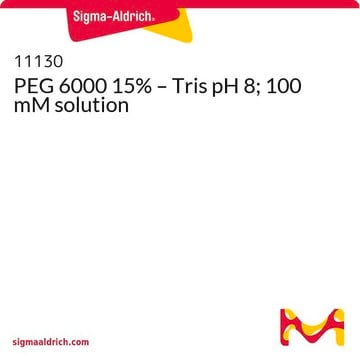41009
Polyethylene glycol solution
12% PEG 8000 – Tris pH 8; 100 mM
Synonym(s):
Crystallization solution 34/Kit-No 02528, Polyethylene glycol
Sign Into View Organizational & Contract Pricing
All Photos(1)
About This Item
UNSPSC Code:
51171641
eCl@ss:
32161000
NACRES:
NA.28
Recommended Products
product name
PEG 8000 12% – Tris pH 8; 100 mM solution,
form
liquid
pH
8.0±0.2 ( in neat)
density
1.02 g/mL at 20 °C
storage temp.
2-8°C
Related Categories
Application
- Polymorphism of microcrystalline urate oxidase from Aspergillus flavus.: This study explores the polymorphic behaviors of urate oxidase crystals under various chemical environments, highlighting modifications in crystal morphology and stability in the presence of additives like polyethylene glycol (PEG) and pH buffers (Collings et al., 2010).
- Crystallization and preliminary X-ray analysis of a recombinant Fab fragment in complex with 17beta-oestradiol.: Details the crystallization process of a Fab fragment bound with 17beta-oestradiol, utilizing a crystallization medium enriched with PEG 8000 and Tris buffer, analyzing its impact on crystal quality and data collection (Lamminmaki and Kankare, 2000).
Storage Class Code
12 - Non Combustible Liquids
WGK
WGK 1
Flash Point(F)
Not applicable
Flash Point(C)
Not applicable
Personal Protective Equipment
dust mask type N95 (US), Eyeshields, Gloves
Certificates of Analysis (COA)
Search for Certificates of Analysis (COA) by entering the products Lot/Batch Number. Lot and Batch Numbers can be found on a product’s label following the words ‘Lot’ or ‘Batch’.
Already Own This Product?
Find documentation for the products that you have recently purchased in the Document Library.
Ryan McCormack et al.
Journal of immunology (Baltimore, Md. : 1950), 204(8), 2242-2256 (2020-03-13)
Type I IFNs play a complex role in determining the fate of microbial pathogens and may also be deleterious to the host during bacterial and viral infections. Upon ligand binding, a receptor proximal complex consisting of IFN-α and -β receptors
Our team of scientists has experience in all areas of research including Life Science, Material Science, Chemical Synthesis, Chromatography, Analytical and many others.
Contact Technical Service

